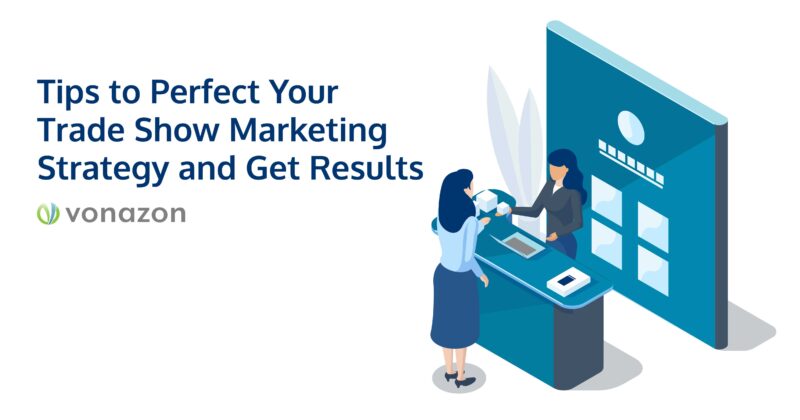
Tips to Perfect Your Trade Show Marketing Strategy and Get Results
Digital marketing dominates today’s advertising landscape. From social media content, Pay-Per-Click (PPC) advertising, Google Ads, and email campaigns, you might ask yourself, “why should I invest in a trade show marketing strategy?” Or, “how am I going to get enough qualified traffic to get an ROI?”
Why Should You Have a Trade Show Marketing Strategy?
The proof is in the numbers:

The person-to-person networking that trade shows offer is priceless. Making personal connections at these events allows you to build new contacts and often solidifies strong business relationships. Plus, you get the chance to establish your company amongst other industry leaders, directly engage your target market, and attract and add new prospects to your marketing contacts list. There are also opportunities for direct selling, but for sales opportunities to occur, you need to gain traction through a trade show marketing strategy and attract the right traffic.
Pre-event trade show planning is a wonderful way to increase traction at your booth.
Trade Show Planning—Pre-Event Strategy 1:

Traditional Advertisements
Phase I: Consider placing an ad in the show’s Trade Show Publication. These publications are sent to all registrants and prospective attendees well in advance of the show—giving you a vast, blanketed reach over your target audience. A teaser-style approach in your ad promoting your booth giveaways, booth number, reveals, new products, and critical services will excite your target base about visiting your booth.
Launching a traditional ad and landing page approximately three months before the show is your best strategy for grabbing attendees’ attention. Include a URL in the ad that links to a landing page containing additional details on special offers, your booth information, and your essential products and services. You can also include a form on the landing page to capture high-interest prospect contact information.
Phase II: Launch additional magazine ads that provide greater context on products linked to the landing page around one month before the show. A well-designed magazine ad will keep your prospective eyes on your brand message and build anticipation.
Trade Show Planning—Pre-Event Strategy 2:

E-Book Content Syndication
Create a white paper on a notable topic your target market is interested in, then leverage affiliate marketing to share the whitepaper with target audiences. Cross-promote the white paper through display banners incorporated on the company website and the event-specific landing page to build more readership. You can also partner with various industry media outlets to promote the whitepaper to their readers.
Trade Show Planning—Pre-Event Strategy 3:

Email Past Attendees
Target past attendees through an email drip campaign series promoting with a dedicated landing page. Emails are a cost-effective marketing strategy you can use to boost trade show attendance and reach those who aren’t able to be at the event. A good email drip campaign should contain three to four targeted emails sent out about a month before the event.
Trade Show Planning—Pre-Event Strategy 4:

Host a Webinar
Develop a webinar that capitalizes on the interest of your new and improved products or services. Launch the webinar during a peak period, around two weeks before the event occurs. Keep the webinar educational in nature so that there is an attractive benefit—a good takeaway will bring more registrations in for the webinar. Provide webinar attendees and those who could not attend a replay link immediately following the webinar.
By hosting a webinar, you’ll have a one-to-many reach to a larger audience, saving you internal resources. A webinar is a great way to boost brand awareness while you position yourself as an expert on topics your target audience is interested in. One of the most significant benefits of a webinar is getting access to qualified leads before the show.
Trade Show Planning—Pre-Event Strategy 5:

PPC Campaigns
A Pay-Per-Click (PPC) campaign has several benefits. This type of campaign can build your online presence. In addition to quickly generating website traffic, a well-crafted PPC campaign can fill your digital sales funnels and help you stay ahead of the competition by siphoning digital traffic away from them.
Start your PPC one month before the event and leverage a broad match of keywords around the event. For ads targeting social media, highlight in-booth activities & demos with eye-catching visuals and clear call-to-action (CTA) driven headlines.
5 Types of PPC Ads
- Search Ads
- Display Ads
- Social Media Ads
- Remarketing Ads
- Gmail Sponsored Promotions
Conclusion
Building buzz through a well-planned pre-event trade show marketing strategy is one of the most effective ways to grow booth traffic with qualified leads. Without a good tradeshow marketing plan, you risk losing ROI for your booth and out on qualified traffic, potential leads, and sales.
Account Executive
Vonazon Inc.

Vonazon can guide you through the process of creating fun and effective short form videos that are unique to your brand. We can also help you create campaigns around your videos that deliver results, grow your brand’s social media presence, and produce more leads.
Contact us today to begin your short form video journey.
Recent Posts
Categories
Categories
- ABM
- Account Management
- Analytics
- Artificial Intelligence
- Content Marketing
- Creative
- CRM
- Design
- eCommerce
- Email Marketing
- HubSpot
- HubSpot CRM
- HubSpot Marketing Hub
- HubSpot Partner
- Inbound Marketing
- Integrations and Migrations
- Lead Generation
- Lead Scoring
- Marketing
- Marketing Automation
- Marketing Strategy
- Native Advertising
- Omnichannel Marketing
- Organization
- PPC
- Programmatic Advertising
- Sales and Marketing Alignment
- SEO
- Social Media
- Staffing
- Trade Shows
- Videos
- Web Development
- Webinars
HOW CAN We
HELP YOU?
Lorem ipsum dolor sit amet, consectetur adipiscing elit.




